Personalized digital experiences are no longer a nice add-on to customer experience (CX). Consumers expect personalization, and 76% get frustrated when they don’t find it. At the same time, businesses that meet that demand generate, on average, 40% more revenue from personalization.
While the need to match customers’ expectations with experiences tailored to them is obvious now, doing it right and at scale is easier said than done.
You may struggle with delivering a smooth CX across multiple channels. Or, your personalization-at-scale efforts may come across as creepy. Or, you might have already implemented personalized content and product offerings but see no tangible results.
As a professional ecommerce agency, we have tackled CX issues for over 100+ brands by building cohesive, unified shopping experiences that are based on people, data, and business processes. Our Elogic Commerce customer stories boom with successful cases of top retailers who have seen their CX reinvented.
Today, you’ll see how embedding data-driven personalization features in every business operation will help you construct a comprehensive, intent-based omnichannel CX. Bookmark this article for future reference: this is your playbook on what personalization at scale is, how it can benefit you, how to adopt it, and more.
What Is Personalization at Scale?
Before we define personalization at scale, we have to answer a different question: what does personalization mean?
Think about your experience as a customer at a physical apparel store. A sales rep can help you find the right outfit for, let’s say, a wedding ceremony. They will certainly tailor their offers depending on your tastes, favorite colors, season, etc. This attention and care add value to your experience and make you feel valued, too.
Personalization in ecommerce is meant to replicate this experience online: on your website, app, marketplace, and any other touchpoint.
Now, let’s return to our original question: What is personalization at scale? It means using technology to analyze vast pools of customer data in real time to deliver highly relevant CX that corresponds to their needs and wants across all touchpoints.
Personalization at scale is characterized by the following:
- Unifying customer data from multiple sources in real time
- Adopting an omnichannel strategy for personalization
- Microsegmenting your customers
- Predicting behavior and personalizing interactions based on intent
- Adapting CX based on interactions and signals in real time
To introduce personalization at scale, you’ll need to collect and process mountains of user data. If that data is trapped in silos or fragmented across multiple sources, you won’t be able to draw the insights you need to get it right.
The Alluring Promise of Digital Personalization at Scale: 5 Benefits You Can Unlock
You may hesitate about implementing a personalization-at-scale strategy since your ecommerce business already generates sales. Let us break down the five reasons you should go through with it anyway, even if your operations seem fine as-is.
Read more: How to Develop a Successful Ecommerce Strategy: Steps & Examples
Meeting customers’ expectations
When it comes to personalization at scale, Adobe states that 87% of senior executives believe that customer expectations have become “digitally rewired.” McKinsey research backs it up: 71% of consumers expect personalization from brands, and 76% get frustrated when it’s not there.

When it comes to particular expectations, the top five are:
- Facilitating navigation
- Suggesting relevant products and services
- Adapting messages to consumers’ needs
- Providing targeted promotions and special offers
- Celebrating consumers’ milestones
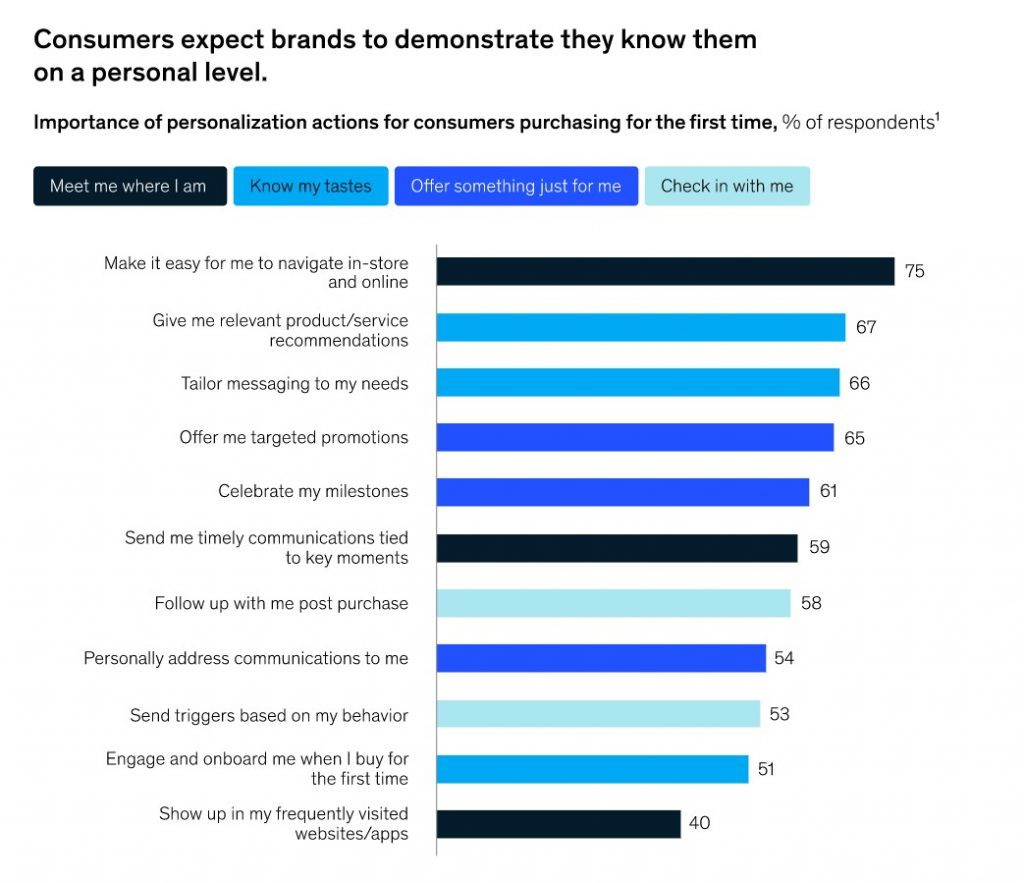
Meeting these expectations implies some major rewards for businesses. Over three-quarters of consumers are more likely to purchase from you and recommend your brand if you personalize their CX. For example, Shopify reported a 94% average increase in conversion rates when ecommerce businesses introduced personalized 3D content.
Growing your ROI
Mass personalization at scale, when done right, increases your revenue. For example, 451 Research puts the revenue boost from personalized cross-selling and recommendations at $5.6 billion. Adobe personalization at scale statistics, in turn, put the YoY revenue growth at 1.7x.
As for the ROI in particular, one study found that in 26% of cases, every dollar spent on personalization had a return of three to five dollars. At the same time, 9% of respondents stated that their ROI was 20 or more dollars on every dollar spent.
Increasing customer retention
Reducing your costs is just one side of the equation. A solid personalization at scale strategy also helps you retain your customers. And as you may know well, customer retention is 5x times more cost-efficient than acquiring a new one.
For instance, McKinsey found that 78% of consumers are likely to make a repeat purchase following a personalized shopping experience. And as of 2022, 62% of consumers say they will abandon a brand after an impersonalized experience, showing a 17% increase since 2021.
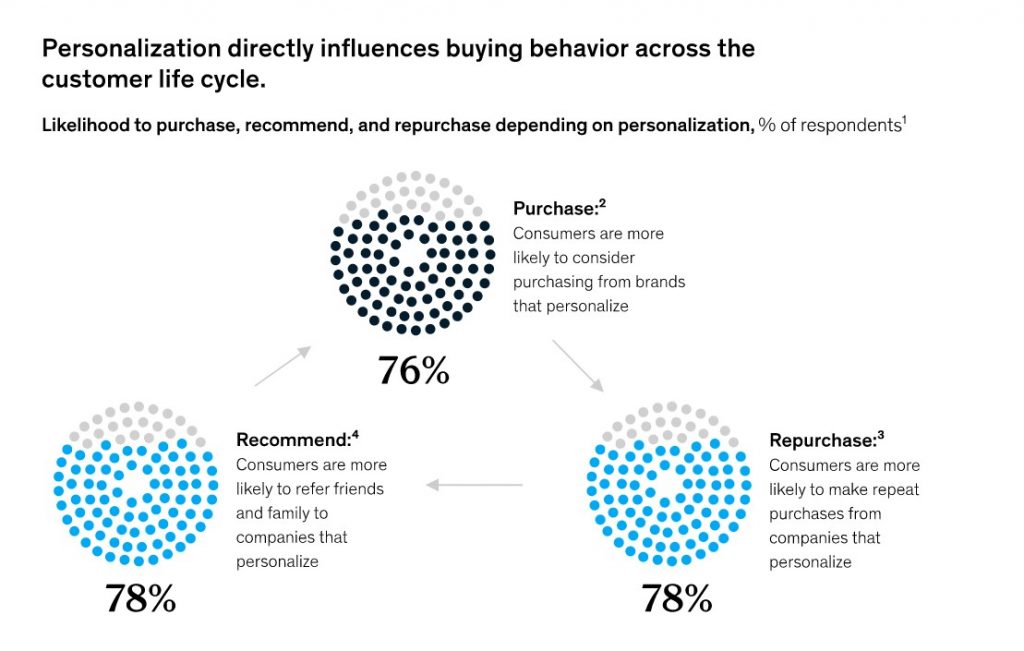
Increasing AOV & CLV
Improved customer retention and satisfaction are great recipes for increasing both average order value and customer lifetime value. For example, Adobe puts the customer lifetime value YoY uplift at 2.3x for brands that introduced personalization in customer experience.
Read more: Ecommerce Conversion Rate Optimization: Top 14 Ecommerce Conversion Tips
McKinsey found that companies excelling at personalization have a two times larger share of customers that spend more year on year (36% vs 18%). They also get more out of loyalty (53% of their sales are linked to a loyalty ID).
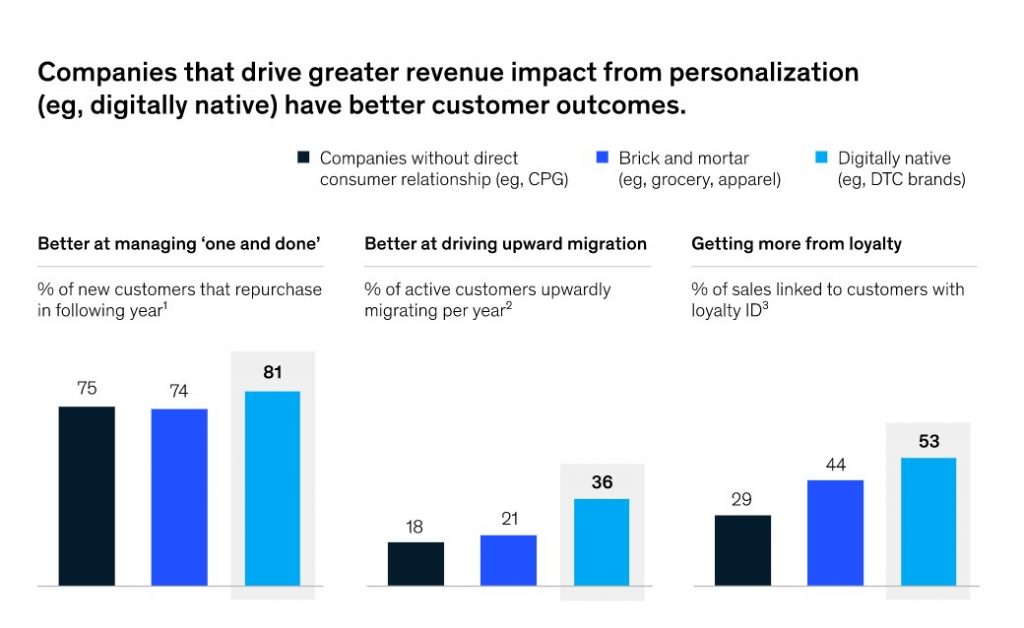
Building trust
Accurate, meaningful personalization makes customers feel valued. This is how you show that you care about them individually and are willing to go that extra mile to deliver an excellent shopping experience.
Customer trust translates into a boost in metrics like conversion and customer retention rates, customer lifetime value, revenue, customer loyalty, and more.
A detailed customer journey mapping will help you pinpoint the ways to personalize the CX that your customers desire. That’s what we did for one of our clients, a Saudi Coffee Roaster. After a thorough mapping and customer behavior analysis, the company added new features like wholesale, digital-only products (like coffee workshops), and gamification. That, in turn, boosted customer loyalty.
5 Ingredients to Successfully Personalize CX at Scale
If you’re ready to proceed with personalization at scale, here are the five pillars of preparing and executing a solid strategy that bears fruit.
Define the roles
If you don’t have a position overseeing all CX efforts yet, you should start by creating one. For example, Home Depot and McDonald’s fill the role of a chief CX officer who oversees the customer lifecycle and puts forward strategies for a positive CX.
Of course, unless you’re running an ecommerce corporation, you don’t have to hire a chief CX officer. Still, you need to establish who will be responsible for strategic decisions vis-à-vis CX. It can be the head of ecommerce, for example.
This person will be responsible for:
- Establishing the project’s vision, KPIs, and budget
- Coordinating CX efforts across all departments
- Defining value propositions
- Analyzing and addressing customer feedback on a large scale
Think like your customer
While 82% of consumers value brands that treat them as individuals, keep in mind that perspectives on personalization at scale may differ. To some, personalization can come off as creepy.
For example, 35% of customers get frustrated when they receive a message from a brand based on information they haven’t shared with it. And 61% of consumers say ads based on data from third-party cookies are outright creepy.
To avoid unintentionally alienating your customers, you need to organize your findings in a customer journey map. It visualizes what they think and expect of you depending on their brand awareness stage and touchpoint. It’ll inform your personalization decisions based on your customers’ pain points at every step of their way.
Here’s an example of a customer journey map that we created for one of our clients:
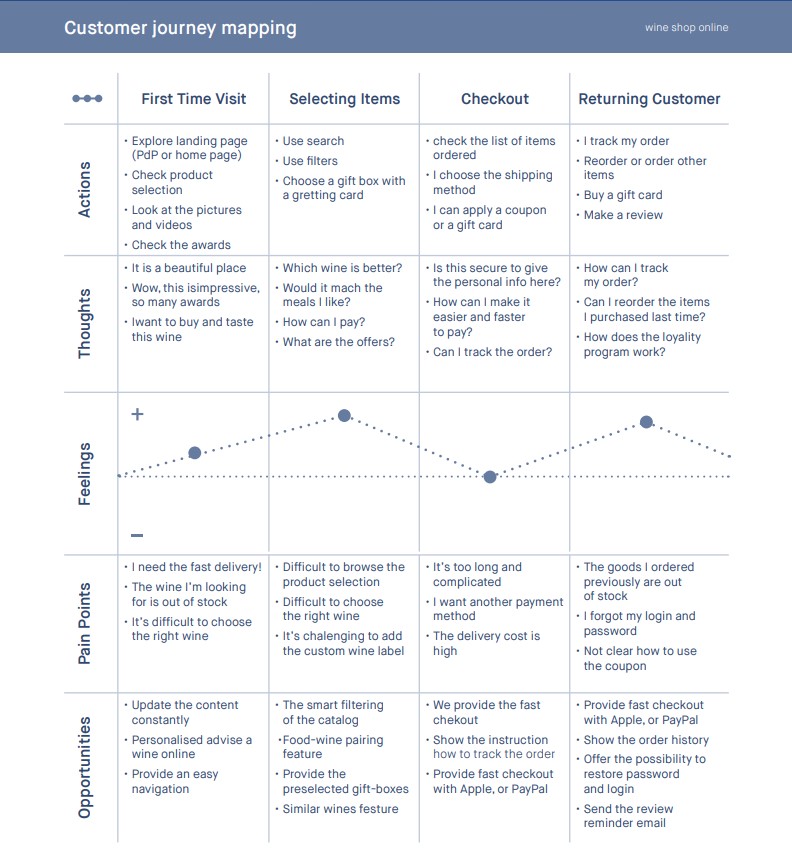
To create a customer journey map, collect data from multiple sources: website and mobile app analytics, surveys, social media, etc.
Unify customer data
To match your customers’ expectations, you’ll need the right data to power your personalization at scale, whether for delivering dynamic content or personalized merchandising. The specific data types and sources vary from business to business.
Here’s what you should strive to learn about your customers through data:
- Who they are
- What led them to your business
- Their stage of awareness and intent
- How you can support them
Ensure customer data isn’t trapped in separate systems to enable seamless data exchange and syncing across all touchpoints. To do so, consider extracting and syncing data from your CRM, ecommerce website, mobile apps, quizzes and polls, web analytics tools, and even POS systems.
Keep in mind that you have to comply with your jurisdiction’s privacy regulations (e.g., GDPR in the EU and CCPA in California) to use customer data.
Leverage advanced analytics
Without advanced analytics, you can’t properly assess and predict user intent. You won’t even be able to make sense of the stockpiles of data you’ve aggregated for personalization at scale.
Advanced analytics uses technologies like machine learning to pinpoint patterns and derive insights from data. It also serves to predict possible scenarios and determine a course of action.
Advanced analytics can involve:
- AI at scale: uses AI algorithms to analyze user behavior and adapt the UX to it in real time.
- Real-time segmentation: creates and continuously updates customer segments in real time, with segment overlap and contact frequency in mind.
- Real-time customer journey analytics: tracks and updates your customer metrics across all touchpoints.
Create a fully integrated tech ecosystem
By definition, personalization at scale requires all teams across the organization to coordinate on CX. This includes sales, marketing, supply chain, manufacturing, IT, data, and other teams.
To power this coordination, you’ll need an orchestration layer that pulls data from, expedites it to multiple sources, and gives your teams access. It should also allow you to organize and make sense of that data.
This means you may need to rethink your software architecture and upgrade or overhaul it to support personalization at scale.
To this end, you may replatform to composable commerce architecture as they come with such a layer by definition.
Read more: Best Headless Ecommerce Platform — Full Guide
Five Successful Personalization at Scale Examples
Let’s break down five examples of personalization at scale for retailers for you to draw inspiration and insight.
Wexon

Wexon is an example of how B2B sellers are offering personalization at scale. This Finnish-based technical component specialist turned to Elogic to revamp its ecommerce solution with personalization in mind.
We transformed Wexon’s online presence from a catalog into a full-fledged interactive store. To introduce personalization at scale, we added custom pricing to the store. Thanks to this feature, B2B customers no longer need to request quotes or contact support.
We also ensured the omnichannel CX was top-notch. If a customer makes an order by phone or in person, they’ll find it in their account’s purchase history.
Starbucks
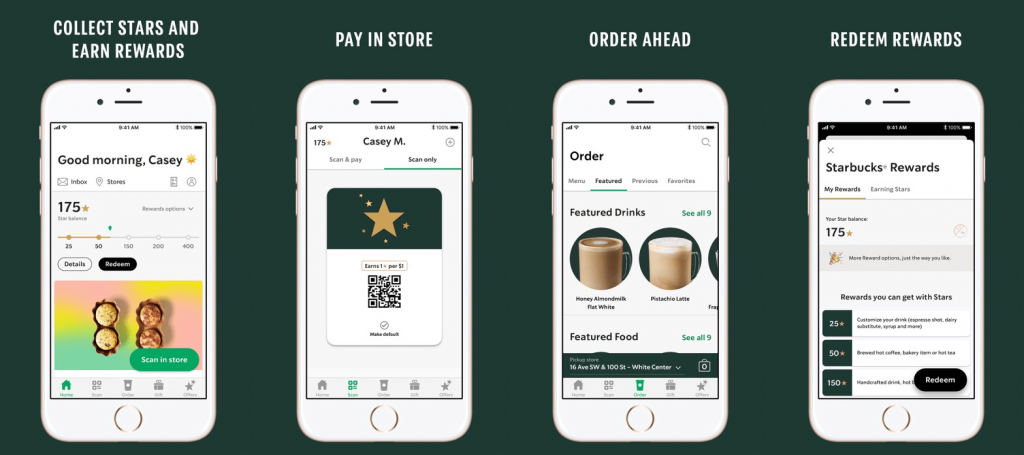
Starbucks used personalization at scale to deliver the same bespoke CX it’s famous for in the new digital-driven era of interaction.
Thanks to reinforcement learning technology embedded in its mobile app, Starbucks Rewards members can now receive recommendations tailored to more than just their preferences. The app takes into account the time of day, weather, and local store inventory.
Forever 21
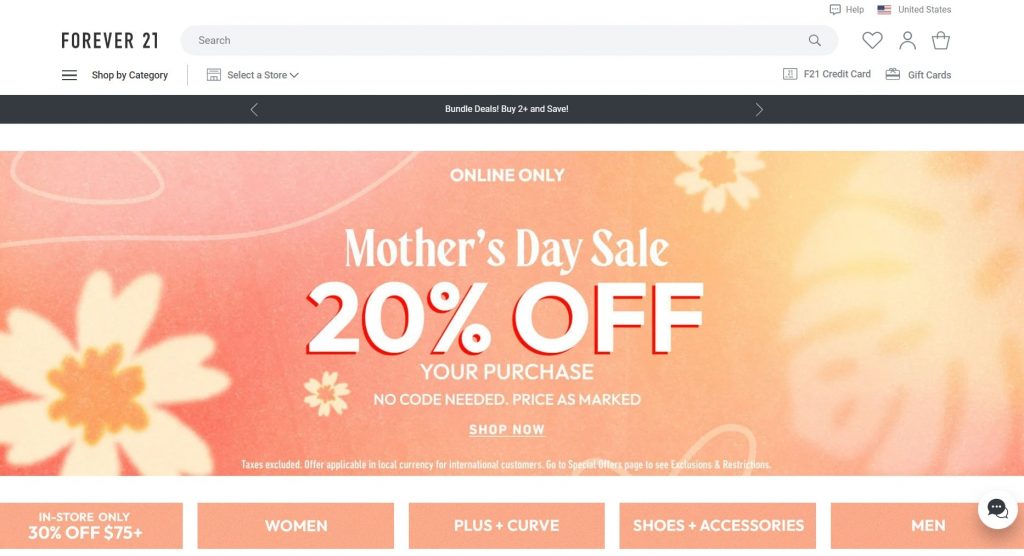
This apparel company went through a rough patch, filing for bankruptcy in 2019, but it’s back in the game. Forever 21 focused its efforts on growing its ecommerce presence, and personalization is its centerpiece.
Forever 21’s online store doesn’t just tailor recommendations to customers’ preferences. The retailer adopted real-time personalization at scale, too. For example, search results are customized based on the user’s clicks and product views.
Sephora
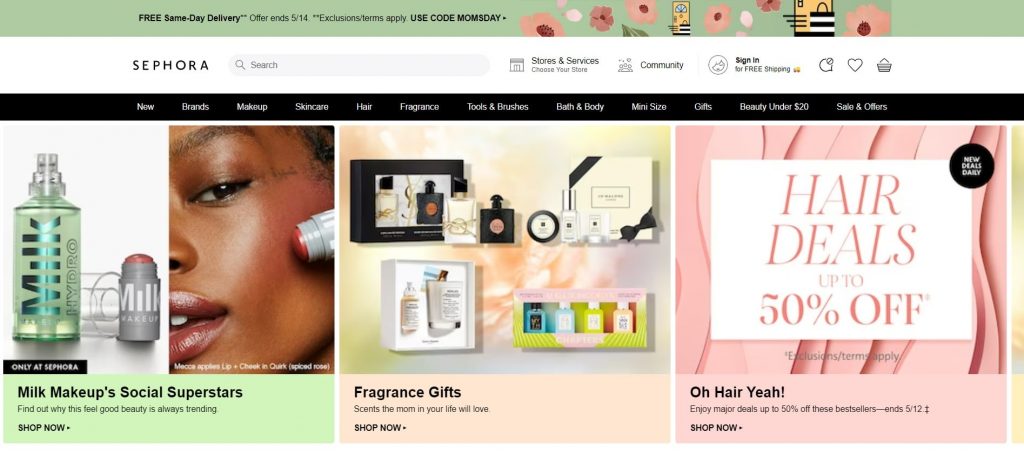
This beauty brand took the well-deserved number one spot in the Retail Personalization Index. Sephora’s advanced recommendation algorithm is one reason why. Powered by predictive analytics and personalized quizzes, it helps customers find exactly what they need.
Furthermore, Sephora is one of the brands that embraced the omnichannel approach to CX early on. Both in-store and online interactions are in sync, allowing for smooth CX personalization.
Zalando

Zalando, a German-based fashion marketplace, was among the first in the European market to use data to drive its personalization efforts.
In 2018, Zalando enlisted the help of AI to power its digital outfit recommendation feature. The algorithm used items on users’ wishlists to suggest full outfits. This paid off: Zalando saw a 40% increase in average order value.
Take the Next Step with Elogic
Personalization at scale is the logical approach to tailoring your CX to individual preferences in a digital-first world. It also entails unparalleled benefits, from increasing conversion rates and customer lifetime value to fostering trust and growing your revenue.
However, personalization at scale has to be implemented right to reap all those benefits. Unifying customer data, introducing advanced analytics, and creating an orchestration layer require solid tech and data expertise.
So, once you assess your personalization goals, see if you have the in-house expertise to achieve them. If not, turn to an external partner for support in your personalization-driven transformation.
We at Elogic would be honored to become such a partner for you. Since 2009, we’ve been helping ecommerce clients across all niches develop and execute digital transformation strategies, from A to Z. Contact us to discuss how we can help you leverage personalization at scale to grow your revenue.
Revamp your CX based on a data-driven customer journey map
Book your ecommerce consultation nowPersonalization at Scale FAQs
How does personalization differ from personalization at scale?
Personalization, in general, refers to tailoring the customer experience to individual preferences, needs, and wants. Personalization at scale, in turn, relies on three key tenets that personalization on its own doesn’t necessarily imply:
- Data-driven CX customization that relies on vast pools of customer information from multiple sources
- Consistent and seamless CX across multiple touchpoints
- Tailoring CX based on predicting customer intent in real time
What are some personalization at scale examples in ecommerce?
Personalization at scale examples include:
- Dynamic website content
- Real-time personalized merchandising
- Custom segmentation based on in-session user behavior
- Tailored loyalty rewards
As for ecommerce businesses that have already adopted personalization at scale, a few prominent examples include Zalando, Starbucks, and Sephora.
How can businesses collect and use customer data for personalization at scale?
You can pull customer data from multiple first- and zero-party sources, like CRMs, ecommerce website(s), mobile app(s), web analytics tools, and quizzes and polls. That data should link back to a unique ID for each customer.
And here’s what you can do with all that data:
- Create a detailed segmentation for your customer base
- Anticipate their shopping needs and intentions
- Use dynamic content on your website
- Personalize merchandising for upselling and cross-selling
- Tailor promotions and special offers to customer intent
How do businesses and customers benefit from personalization at scale?
With a solid personalization-at-scale strategy, businesses can:
- Meet customers’ expectations
- Grow their revenues and ROI
- Increase customer retention, average order value, and customer lifetime value
- Foster trust among their customers
Consumers, in turn, can benefit from personalization at scale by:
- Finding what they search for faster
- Getting tailored promotions and offers
- Having the same outstanding CX across all channels and devices
What are the two main reasons to use personalization in ecommerce?
The two key reasons to adopt personalization in ecommerce are:
- Revenue boost. Multiple studies and estimates show an increase in revenue in companies that adopt personalization at scale. Adobe puts the figure at 1.7x year-on-year, while McKinsey estimates it at 40% on average.
- Customer loyalty. Consumers expect personalization by default – and get frustrated when it’s not there. Meeting this expectation increases brand loyalty and customer retention, conversion rates, and lifetime value.
What is personalization in marketing?
In marketing, personalization refers to tailoring campaigns and messaging to the customer’s preferences, behaviors, and intents. Its goal is to deliver relevant offers for every customer, thus increasing conversion rates.


